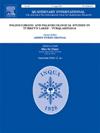Tracing the transfers of raw materials in the Gravettian of Moravia and Silesia
IF 1.9
3区 地球科学
Q3 GEOGRAPHY, PHYSICAL
引用次数: 0
Abstract
In order to reconstruct the procurement pattern of lithics in the Moravian/Silesian Gravettian culture and to make a comparison with neighbouring areas, raw material analysis from five Gravettian sites in Moravia/Silesia (Czech Republic) was carried out using stereomicroscopy and laser ablation inductively coupled plasma mass spectrometry (LA-ICP-MS). In Moravia, the characteristic raw material economy of the Gravettian was the import of fine-grained cherts and erratic flints from northern Moravia (and Silesia) or Southern Poland. However, radiolarites from the Pieniny Klippen Belt (present-day Slovakia and Poland) were also used and complemented on sites under the Pavlovské vrchy Hills by local (gravel) materials. Elemental analysis has also confirmed the use of Hungarian radiolarites at Moravian sites. However, these, as well as obsidian from Eastern Slovakia, were rarely used. The contact between Moravia and these two areas (Eastern Slovakia and Hungary) was probably less intensive than with Lower Austria and Southern Poland. Compared to the procurement pattern of the preceding Aurignacian culture, the most striking difference is the longer (and costly) transfers of erratic flints in the Gravettian. These now dominated the lithic material even at sites along the Danube River, 250 km from their sources. This probably correlates with organised provisioning of large, semi-permanent sites and specialised hunting.
追踪摩拉维亚和西里西亚格拉维特地区的原材料转移
为了重建摩拉维亚/西里西亚格拉韦提文化中石器的获取模式,并与邻近地区进行比较,使用立体显微镜和激光烧蚀电感耦合等离子体质谱(LA-ICP-MS)对莫拉维亚/西里西亚(捷克共和国)格拉韦提五个遗址的原材料进行了分析。在摩拉维亚,格拉维特人特有的原材料经济是从摩拉维亚北部(和西里西亚)或波兰南部进口细粒燧石和不稳定的燧石。然而,来自Pieniny Klippen带(今天的斯洛伐克和波兰)的放射石也被用于pavlovskerovchy山下的遗址,并被当地的(砾石)材料所补充。元素分析也证实在摩拉维亚遗址使用了匈牙利放射石。然而,这些以及来自斯洛伐克东部的黑曜石很少被使用。摩拉维亚与这两个地区(斯洛伐克东部和匈牙利)的联系可能不如与下奥地利和波兰南部的联系密切。与之前奥里尼亚期文化的获取模式相比,最显著的区别是格拉维特时期不稳定的燧石的转移时间更长(而且成本更高)。现在,即使在距离其来源250公里的多瑙河沿岸,它们也占主导地位。这可能与有组织地提供大型半永久性场所和专门狩猎有关。
本文章由计算机程序翻译,如有差异,请以英文原文为准。
求助全文
约1分钟内获得全文
求助全文
来源期刊

Quaternary International
地学-地球科学综合
CiteScore
5.60
自引率
4.50%
发文量
336
审稿时长
3 months
期刊介绍:
Quaternary International is the official journal of the International Union for Quaternary Research. The objectives are to publish a high quality scientific journal under the auspices of the premier Quaternary association that reflects the interdisciplinary nature of INQUA and records recent advances in Quaternary science that appeal to a wide audience.
This series will encompass all the full spectrum of the physical and natural sciences that are commonly employed in solving Quaternary problems. The policy is to publish peer refereed collected research papers from symposia, workshops and meetings sponsored by INQUA. In addition, other organizations may request publication of their collected works pertaining to the Quaternary.
 求助内容:
求助内容: 应助结果提醒方式:
应助结果提醒方式:


